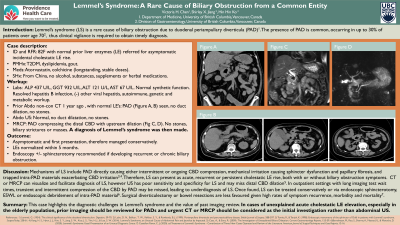Monday Poster Session
Category: Biliary/Pancreas
P1479 - Lemmel's Syndrome: A Rare Cause of Biliary Obstruction From a Common Entity
Monday, October 23, 2023
10:30 AM - 4:15 PM PT
Location: Exhibit Hall

Has Audio

Victoria Chen, MD
University of British Columbia
Vancouver, BC, Canada
Presenting Author(s)
Victoria Chen, MD, Shirley Jiang, MD, Hin Hin Ko, MD, FRCPC
University of British Columbia, Vancouver, BC, Canada
Introduction: Lemmel’s syndrome is a rare cause of biliary obstruction due to duodenal periampullary diverticula (PAD). The presence of PAD is common, occurring in up to 30% of patients over age 70, thus clinical vigilance is required to obtain timely diagnosis.
Case Description/Methods: An 82-year-old female was referred for incidental, asymptomatic cholestatic liver enzyme (LE) elevations. Blood work from 7 months prior was normal. She had a history of diabetes, dyslipidemia, and gout and she has been on atorvastatin and colchicine for years. She did not consume any alcohol or herbal medications. Her bilirubin was 4 umol/L, ALP 437 U/L, GGT 932 U/L, ALT 121 U/L, AST 67 U/L. Liver synthetic function was normal. She had a detailed initial workup: viral serologies showed resolved hepatitis B infection; autoimmune, genetic and metabolic workup were all negative. Abdominal ultrasound was normal, with no stones or biliary dilatation. Prior chart review showed she underwent a non-contrast computed tomography (CT) scan 7 months prior for acute onset of nausea, vomiting and diarrhea, which subsequently self-resolved. Her LEs were normal at that time. The CT scan did not show any biliary ductal dilation or cholelithiasis, but incidentally noted PAD. Magnetic resonance cholangiopancreatography (MRCP) was then ordered and this re-demonstrated the PAD, now compressing the distal common bile duct (CBD) with resultant upstream dilation. No stones, biliary strictures or masses were seen. A diagnosis of Lemmel’s syndrome was then made. As she was asymptomatic and this was her first presentation, she was managed conservatively. Her LEs normalized within 5 months. Endoscopic evaluation and possible sphincterotomy were recommended if she develops recurrent or chronic biliary obstruction.
Discussion: This case highlights the diagnostic challenges in Lemmel’s syndrome and the value of past imaging review. Ultrasound is often the initial imaging of choice in LE elevation but has poor sensitivity for PAD and distal CBD dilation. Lemmel’s syndrome may also cause transient or recurrent biliary obstruction, thus timely and sensitive imaging is needed to capture the PAD as the culprit. In cases of unexplained acute cholestatic LE elevation, especially in the elderly population, prior imaging should be reviewed for PAD and urgent CT or MRCP should be considered as the initial investigation rather than abdominal ultrasound.
Disclosures:
Victoria Chen, MD, Shirley Jiang, MD, Hin Hin Ko, MD, FRCPC. P1479 - Lemmel's Syndrome: A Rare Cause of Biliary Obstruction From a Common Entity, ACG 2023 Annual Scientific Meeting Abstracts. Vancouver, BC, Canada: American College of Gastroenterology.
University of British Columbia, Vancouver, BC, Canada
Introduction: Lemmel’s syndrome is a rare cause of biliary obstruction due to duodenal periampullary diverticula (PAD). The presence of PAD is common, occurring in up to 30% of patients over age 70, thus clinical vigilance is required to obtain timely diagnosis.
Case Description/Methods: An 82-year-old female was referred for incidental, asymptomatic cholestatic liver enzyme (LE) elevations. Blood work from 7 months prior was normal. She had a history of diabetes, dyslipidemia, and gout and she has been on atorvastatin and colchicine for years. She did not consume any alcohol or herbal medications. Her bilirubin was 4 umol/L, ALP 437 U/L, GGT 932 U/L, ALT 121 U/L, AST 67 U/L. Liver synthetic function was normal. She had a detailed initial workup: viral serologies showed resolved hepatitis B infection; autoimmune, genetic and metabolic workup were all negative. Abdominal ultrasound was normal, with no stones or biliary dilatation. Prior chart review showed she underwent a non-contrast computed tomography (CT) scan 7 months prior for acute onset of nausea, vomiting and diarrhea, which subsequently self-resolved. Her LEs were normal at that time. The CT scan did not show any biliary ductal dilation or cholelithiasis, but incidentally noted PAD. Magnetic resonance cholangiopancreatography (MRCP) was then ordered and this re-demonstrated the PAD, now compressing the distal common bile duct (CBD) with resultant upstream dilation. No stones, biliary strictures or masses were seen. A diagnosis of Lemmel’s syndrome was then made. As she was asymptomatic and this was her first presentation, she was managed conservatively. Her LEs normalized within 5 months. Endoscopic evaluation and possible sphincterotomy were recommended if she develops recurrent or chronic biliary obstruction.
Discussion: This case highlights the diagnostic challenges in Lemmel’s syndrome and the value of past imaging review. Ultrasound is often the initial imaging of choice in LE elevation but has poor sensitivity for PAD and distal CBD dilation. Lemmel’s syndrome may also cause transient or recurrent biliary obstruction, thus timely and sensitive imaging is needed to capture the PAD as the culprit. In cases of unexplained acute cholestatic LE elevation, especially in the elderly population, prior imaging should be reviewed for PAD and urgent CT or MRCP should be considered as the initial investigation rather than abdominal ultrasound.
Disclosures:
Victoria Chen indicated no relevant financial relationships.
Shirley Jiang indicated no relevant financial relationships.
Hin Hin Ko: AbbVie – Advisory Committee/Board Member, Consultant, Clinical Investigator, Speakers Bureau. Celgene – Clinical Investigator. Escient – Clinical Investigator. Gilead – Advisory Committee/Board Member, Consultant, Clinical Investigator, Speakers Bureau. Intercept – Advisory Committee/Board Member, Consultant, Clinical Investigator, Speakers Bureau. Ipsen – Advisory Committee/Board Member, Consultant, Clinical Investigator. Lupin – Advisory Committee/Board Member, Consultant, Speakers Bureau. Madrigal – Clinical Investigator. Merck – Advisory Committee/Board Member, Consultant, Clinical Investigator, Speakers Bureau. Pilant – Clinical Investigator. Sanofi – Advisory Committee/Board Member, Consultant, Clinical Investigator, Speakers Bureau.
Victoria Chen, MD, Shirley Jiang, MD, Hin Hin Ko, MD, FRCPC. P1479 - Lemmel's Syndrome: A Rare Cause of Biliary Obstruction From a Common Entity, ACG 2023 Annual Scientific Meeting Abstracts. Vancouver, BC, Canada: American College of Gastroenterology.
